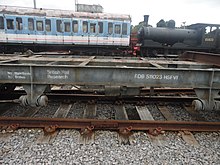
A bogie is a chassis or framework that carries a wheelset, attached to a vehicle—a modular subassembly of wheels and axles. Bogies take various forms in various modes of transport. A bogie may remain normally attached or be quickly detachable ; it may contain a suspension within it, or be solid and in turn be suspended ; it may be mounted on a swivel, as traditionally on a railway carriage or locomotive, additionally jointed and sprung, or held in place by other means.
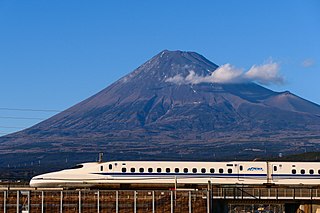
High-speed rail (HSR) is a type of rail system that runs significantly faster than traditional rail, using an integrated system of specialised rolling stock and dedicated tracks. While there is no single standard that applies worldwide, lines built to handle speeds above 250 km/h (155 mph) or upgraded lines in excess of 200 km/h (124 mph) are widely considered to be high-speed. The first high-speed rail system, the Tōkaidō Shinkansen, began operations in Japan in 1964 and was widely known as the bullet train.

A tilting train is a train that has a mechanism enabling increased speed on regular rail tracks. As a train rounds a curve at speed, objects inside the train experience centrifugal force. This can cause packages to slide about or seated passengers to feel squashed by the outboard armrest, and standing passengers to lose their balance. Tilting trains are designed to counteract this by tilting the carriages towards the inside of the curve, thus compensating for the g-force. The train may be constructed such that inertial forces cause the tilting, or it may have a computer-controlled powered mechanism.

The Advanced Passenger Train (APT) was a tilting high speed train developed by British Rail during the 1970s and early 1980s, for use on the West Coast Main Line (WCML). The WCML contained many curves, and the APT pioneered the concept of active tilting to address these, a feature that has since been copied on designs around the world. The experimental APT-E achieved a new British railway speed record on 10 August 1975 when it reached 152.3 miles per hour (245.1 km/h), only to be bested by the service prototype APT-P at 162.2 miles per hour (261.0 km/h) in December 1979, a record that stood until September 2006.
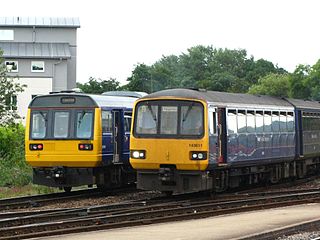
Pacer was the operational name of the British Rail Classes 140, 141, 142, 143 and 144 diesel multiple unit railbuses, built between 1980 and 1987. They were inexpensively developed using a passenger body based on the Leyland National bus on top of a chassis based on the HSFV1 research vehicle. The railbuses were intended as a short-term solution to a shortage of rolling stock, with a lifespan of no more than 20 years. As modernised replacements were lacking, the Pacer fleet remained in service on some lines until 2021 – 37 years after their introduction in 1984.

Suspension is the system of tires, tire air, springs, shock absorbers and linkages that connects a vehicle to its wheels and allows relative motion between the two. Suspension systems must support both road holding/handling and ride quality, which are at odds with each other. The tuning of suspensions involves finding the right compromise. It is important for the suspension to keep the road wheel in contact with the road surface as much as possible, because all the road or ground forces acting on the vehicle do so through the contact patches of the tires. The suspension also protects the vehicle itself and any cargo or luggage from damage and wear. The design of front and rear suspension of a car may be different.

Maglev, is a system of train transportation that uses two sets of electromagnets: one set to repel and push the train up off the track, and another set to move the elevated train ahead, taking advantage of the lack of friction. Such trains rise approximately 10 centimetres (3.9 in) off the track. There are both high speed, intercity maglev systems, and low speed, urban maglev systems being built and under construction and development.
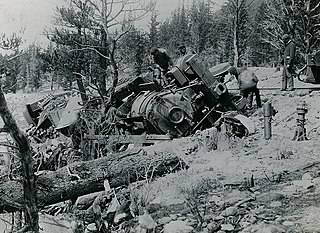
In rail transport, a derailment occurs when a rail vehicle such as a train comes off its rails. Although many derailments are minor, all result in temporary disruption of the proper operation of the railway system and they are a potentially serious hazard.

HS4000 Kestrel was a prototype high-powered mainline diesel locomotive that was built in 1967 by Brush Traction, Loughborough, as a technology demonstrator for potential future British Rail and export orders. The locomotive number is a combination of the initials of Hawker Siddeley and the power rating of its Sulzer diesel engine, making it the most powerful locomotive built by the company.

The LRC is a series of lightweight diesel-powered passenger trains that were used on short- to medium-distance inter-city service in the Canadian Provinces of Ontario and Quebec.

The British Rail Research Division was established in 1964 directly under the control of the British Railways Board, moving into purpose-built premises at the Railway Technical Centre in Derby. The intention was to improve railway reliability and efficiency, while reducing costs and improving revenue. In so doing it became recognised as a centre of excellence and, in time, was providing consultancy to other railways around the world. While it became famous for the Advanced Passenger Train (APT), its activities extended into every area of railway operation. The theoretical rigour of its approach to railway engineering superseded the ad hoc methods that had prevailed previously.

The SCMaglev is a magnetic levitation (maglev) railway system developed by Central Japan Railway Company and the Railway Technical Research Institute.
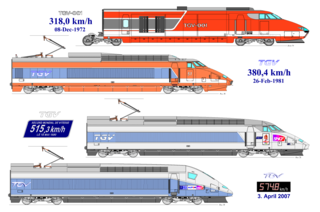
The TGV holds a series of land speed records for rail vehicles achieved by SNCF, the French national railway, and its industrial partners. The high-speed trials are intended to expand the limits of high-speed rail technology, increasing speed and comfort without compromising safety.
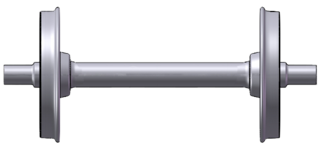
A wheelset is a pair of railroad vehicle wheels mounted rigidly on an axle such that both wheels rotate in unison. Wheelsets are often mounted in a bogie – a pivoted frame assembly holding at least two wheelsets – at each end of the vehicle. Most modern freight cars and passenger cars have bogies each with two wheelsets, but three wheelsets are used in bogies of freight cars that carry heavy loads, and three-wheelset bogies are under some passenger cars. Four-wheeled goods wagons that were once near-universal in Europe and Great Britain and their colonies have only two wheelsets; in recent decades such vehicles have become less common as trainloads have become heavier.

The DR Class 243 is a universal electric locomotive of the Deutsche Reichsbahn which is used for general rail service. Deutsche Bahn lists the locomotive as Class 143. The locomotives of class 143/243 still belong to the most successful class of German electric locomotives.

Goods wagons or freight wagons, also known as goods carriages, goods trucks, freight carriages or freight trucks, are unpowered railway vehicles that are used for the transportation of cargo. A variety of wagon types are in use to handle different types of goods, but all goods wagons in a regional network typically have standardized couplers and other fittings, such as hoses for air brakes, allowing different wagon types to be assembled into trains. For tracking and identification purposes, goods wagons are generally assigned a unique identifier, typically a UIC wagon number, or in North America, a company reporting mark plus a company specific serial number.

The DR 130 family of locomotives comprises the DR Class 130, DR Class 131, DR Class 132 and DR Class 142, in USSR locomotive called TE109 and TE129.

Tracked Hovercraft was an experimental high speed train developed in the United Kingdom during the 1960s. It combined two British inventions, the hovercraft and linear induction motor, in an effort to produce a train system that would provide 250 mph (400 km/h) inter-city service with lowered capital costs compared to other high-speed solutions. Substantially similar to the French Aérotrain and other hovertrain systems of the 1960s, Tracked Hovercraft suffered a similar fate to these projects when it was cancelled as a part of wide budget cuts in 1973.
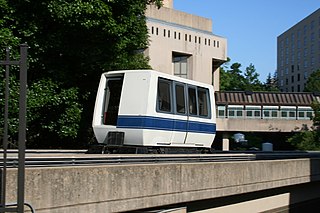
A hovertrain is a type of high-speed train that replaces conventional steel wheels with hovercraft lift pads, and the conventional railway bed with a paved road-like surface, known as the track or guideway. The concept aims to eliminate rolling resistance and allow very high performance, while also simplifying the infrastructure needed to lay new lines. Hovertrain is a generic term, and the vehicles are more commonly referred to by their project names where they were developed. In the UK they are known as tracked hovercraft, in the US they are tracked air-cushion vehicles. The first hovertrain was developed by Jean Bertin (1917-1975) in France, where they were marketed as the Aérotrain before being abandoned by the French government.
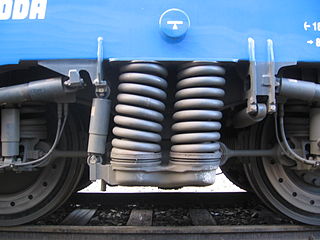
Flexicoil suspension is a type of secondary suspension for railway vehicles, typically having steel coil springs between the bogie trucks and chassis/frame of a passenger coach, goods freight wagon, or locomotive. Suspension systems using steel springs are more common than those with air springs, as steel springs are less costly to make, relatively wear resistant, and require less maintenance.
